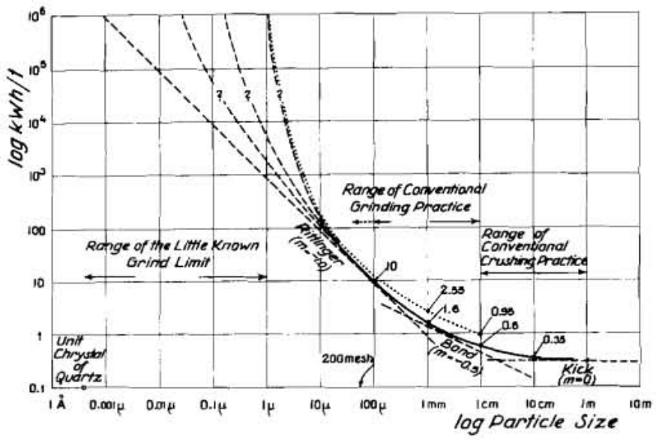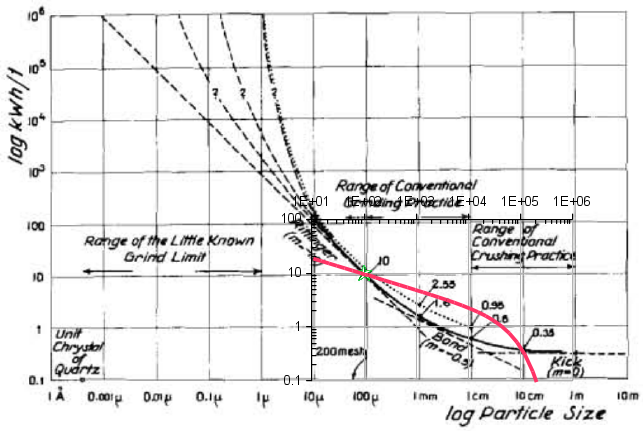Difference between revisions of "Category:Models"
(→Theory of Power Models) |
(→History of Power Models) |
||
| Line 6: | Line 6: | ||
==History of Power Models== |
==History of Power Models== |
||
| − | A systematic relationship between energy consumed in grinding and size reduction was proposed by Peter von Rittinger in 1867, yielding the first Power Model and beginning of comminution as a science [[Bibliography: Specific energy consumption models|<sup>Lynch & Rowland, 2005</sup>]]. This was followed in 1885 by the theory of Friedrich Kick who proposed a much different power model. Instruments of that age did not allow accurate enough measurements to test the theories [[Bibliography: Specific energy consumption models|<sup>Lynch & Rowland, 2005</sup>]], so the difference between the models was largely of academic interest. Not until instruments for motor power measurement and laboratory grinding mills were standardized in the late 1930's to 1940's were attempts made to bench-mark the theories of von Rittinger and Kick to operating grinding plants (one such attempt was [[Bibliography: Benchmarking|Myers, Michaelson & Bond, AIME 1947]]. The failure of these rod mill and ball mill bench-mark studies to validate either model led to the development of a "Third Theory" by Fred Bond [[Bibliography: Specific energy consumption models|<sup>Bond 1952</sup>]]. |
+ | A systematic relationship between energy consumed in grinding and size reduction was proposed by Peter von Rittinger in 1867, yielding the first Power Model and beginning of comminution as a science [[Bibliography: Specific energy consumption models|<sup>Lynch & Rowland, 2005</sup>]]. This was followed in 1885 by the theory of Friedrich Kick who proposed a much different power model. Instruments of that age did not allow accurate enough measurements to test the theories [[Bibliography: Specific energy consumption models|<sup>Lynch & Rowland, 2005</sup>]], so the difference between the models was largely of academic interest. Not until instruments for motor power measurement and laboratory grinding mills were standardized in the late 1930's to 1940's were attempts made to bench-mark the theories of von Rittinger and Kick to operating grinding plants (one such attempt was [[Bibliography: Benchmarking|Myers, Michaelson & Bond, AIME 1947]]. The failure of these rod mill and ball mill bench-mark studies to validate either model led to the development of a "Third Theory" by Fred Bond [[Bibliography: Specific energy consumption models|<sup>Bond 1952</sup>]]. |
| + | |||
| + | [[Bibliography: Specific energy consumption models|R. Hukki in 1962]] showed that all three theories may be special cases of a spectrum of a larger, more generalized, theory where Kick best characterized the coarsest particles (blasting), Bond the middle size ranges (rod and ball milling), and von Rittinger the finest size classes (fine and ultra-fine grinding). |
||
| + | [[File:Hukki1962-chart.png]] |
||
| + | |||
| + | A later model by [[Bibliography: Specific energy consumption models|Stephen Morrell]] attempted to smoothly merge all three of the earlier models into a single continuum that was fitted to surveys Morrell conducted in Australasia and Africa. However, the exponents derived by Morrell are very different from the exponents predicted by Hukki and, in the finest size classes, do not match observed signature plots from tests involving stirred mills (e.g. Isamills and Vertimills). |
||
| + | |||
| + | [[File:Hukki_Morrell-chart.png]] |
||
==Theory of Power Models== |
==Theory of Power Models== |
||
Revision as of 01:30, 5 December 2013
Models
This are two principal types of models in SAGMILLING.COM:
- Specific energy consumption models are used to estimate the amount of grinding energy required to grind a particular ore, and what throughput can be achieved by passing that ore through a particular set of grinding mills.
- Mill power draw models are used to estimate how much grinding energy can be generated by a particular mill geometry and charge.
History of Power Models
A systematic relationship between energy consumed in grinding and size reduction was proposed by Peter von Rittinger in 1867, yielding the first Power Model and beginning of comminution as a science Lynch & Rowland, 2005. This was followed in 1885 by the theory of Friedrich Kick who proposed a much different power model. Instruments of that age did not allow accurate enough measurements to test the theories Lynch & Rowland, 2005, so the difference between the models was largely of academic interest. Not until instruments for motor power measurement and laboratory grinding mills were standardized in the late 1930's to 1940's were attempts made to bench-mark the theories of von Rittinger and Kick to operating grinding plants (one such attempt was Myers, Michaelson & Bond, AIME 1947. The failure of these rod mill and ball mill bench-mark studies to validate either model led to the development of a "Third Theory" by Fred Bond Bond 1952.
R. Hukki in 1962 showed that all three theories may be special cases of a spectrum of a larger, more generalized, theory where Kick best characterized the coarsest particles (blasting), Bond the middle size ranges (rod and ball milling), and von Rittinger the finest size classes (fine and ultra-fine grinding).

A later model by Stephen Morrell attempted to smoothly merge all three of the earlier models into a single continuum that was fitted to surveys Morrell conducted in Australasia and Africa. However, the exponents derived by Morrell are very different from the exponents predicted by Hukki and, in the finest size classes, do not match observed signature plots from tests involving stirred mills (e.g. Isamills and Vertimills).
Theory of Power Models
Authors such as Taggart and Bond noted several properties of common size reduction processes that allows modelling as a process of energy consumption by and ore1,2. The underlying observations (and assumptions) of Power Models are:
- Any particle size distribution can be modelled by a single value. Generally, it is the 80% passing size that is used as being indicative of the entire size distribution.
- Particle size distributions of "normal" size reduction processes produce "similar" particle size curves, generally with the feed and product having the same proportions of "coarse" and "fines" where only the sizes that define coarse and fine are shifted.
In general, the mill power draw models are independent of the ore being processed (ore density matters, but feed and product sizes should not affect power draw if the mill is run properly). The specific energy model uses the ore grindability test results to estimate energy requirements to achieve a particular size reduction, then it calls on the mill power draw model to determine how much energy is actually available. Dividing the energy available by the specific energy consumption results in the throughput.
Pages in category "Models"
The following 22 pages are in this category, out of 22 total.
M
- Mill power draw models
- Model:Amelunxen SGI
- Model:Bond RMBM Model
- Model:Bond-Rowland SSBM
- Model:Bond/Barratt SAB Model
- Model:Bond/Barratt SABC Models
- Model:Bond/Barratt SS SAG
- Model:El Soldado SS SAG
- Model:Morrell HPGR and ball mill
- Model:Morrell Mi SMC SAG
- Model:Morrell SS SAG
- Model:Morrell SSBM
- Model:Raw Bond/Barratt SAB & SABC Model
- Morrell C-model
